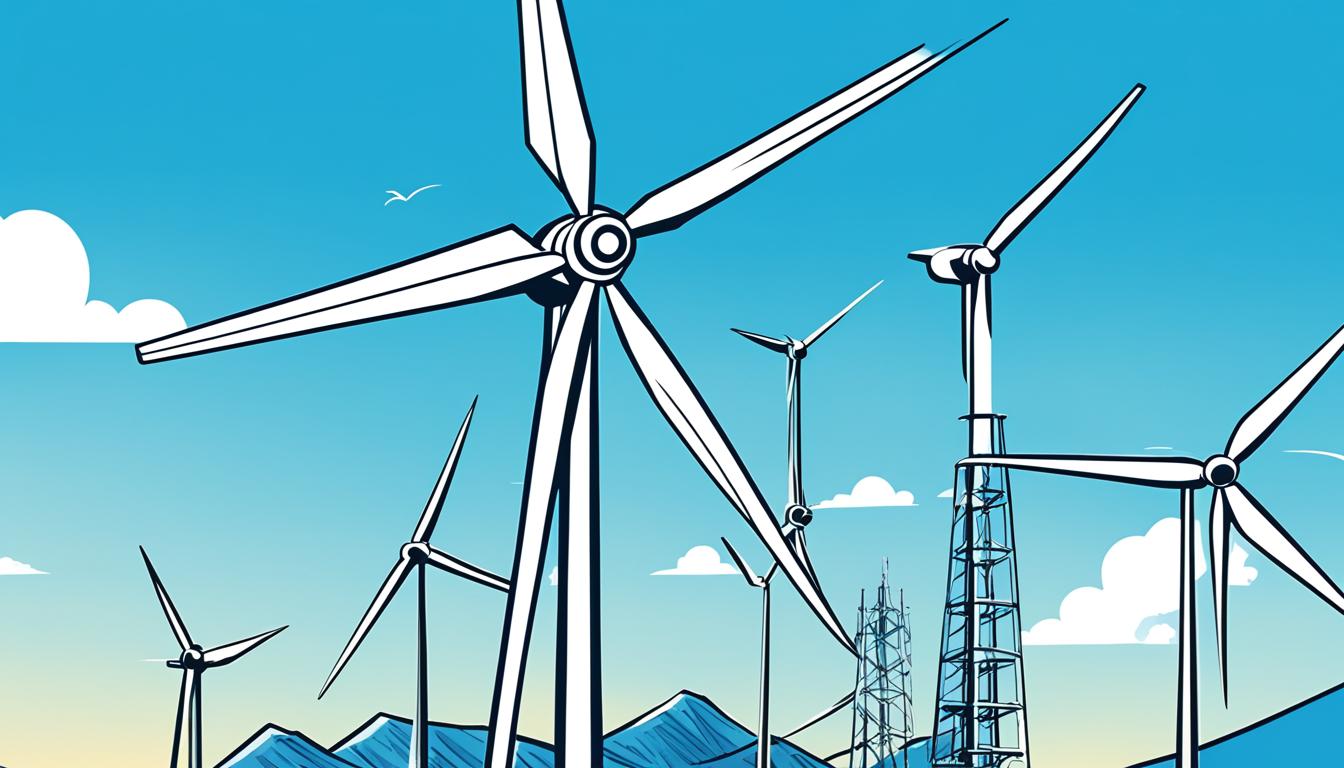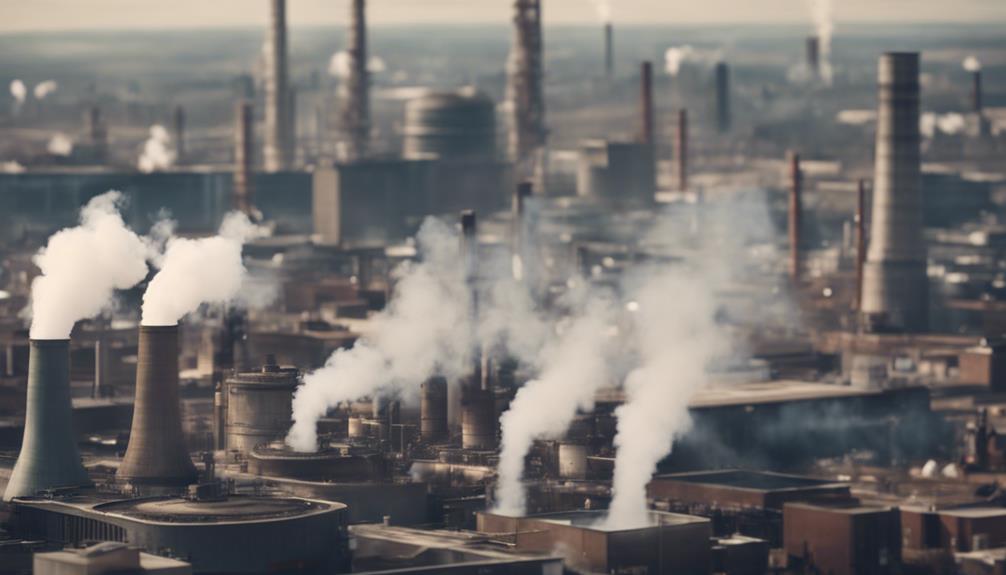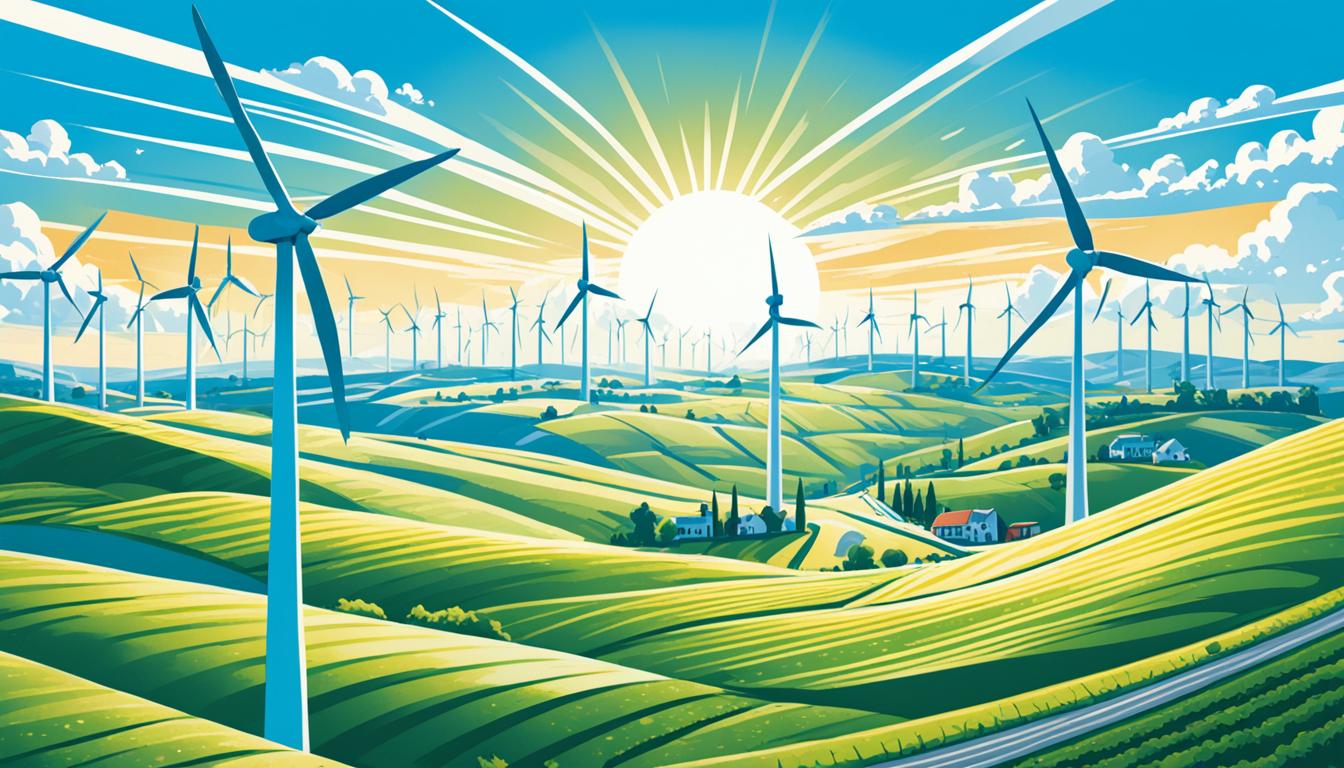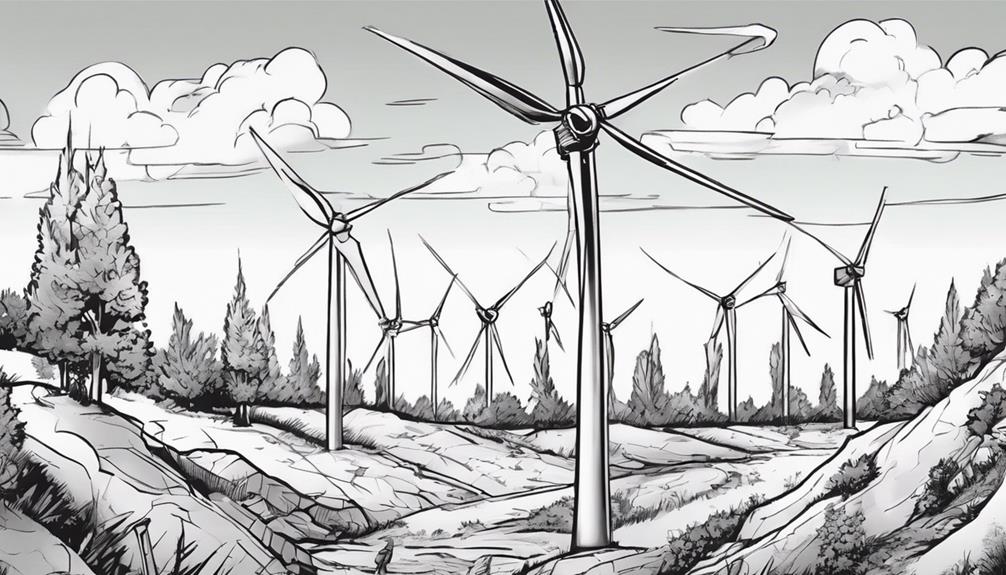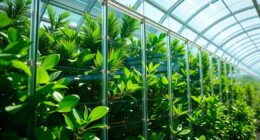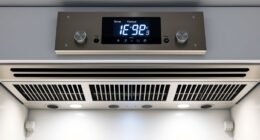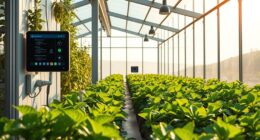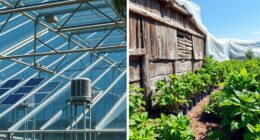Did you know that the energy output of wind farms can be increased by optimizing the orientation of individual turbines? Traditional control systems focus on maximizing the power production of each turbine independently, disregarding the impact on neighboring turbines. However, cutting-edge research has revealed that by considering the overall wind flow within a wind farm, energy output can be significantly improved.
An algorithm developed by Michael Howland and his team, and published in Nature Energy1, has shown promising results in enhancing energy production. By adjusting the operation of turbines based on the wind flow of the entire wind farm, the algorithm has demonstrated increased energy output between 1 and 3 percent, depending on wind speed1. If implemented across the world’s existing wind farms, this algorithm could potentially power 3 million homes1.
To understand the significance of this optimization, consider that wake effects can decrease total electricity production in wind farms by 10 to 20 percent1. By minimizing the wake interactions among turbines through optimal orientation, more energy can be harnessed and utilized efficiently. This translates not only to a tangible increase in energy generation but also to substantial financial benefits for power producers, with a potential revenue gain of almost a billion dollars per year1.
The allure of wind energy lies in its potential to contribute significantly to achieving net zero emissions and combatting climate change. As renewables like wind and solar are projected to produce the majority of the world’s electricity in the future1, it is crucial to explore innovative approaches to maximize their efficiency and output. One of the key areas of focus is optimizing wind turbine orientation within wind farms, leading to an overall boost in energy production1.
Key Takeaways:
- Optimizing wind turbine orientation within wind farms can increase energy output by 1.2 percent overall and up to 3 percent for optimal wind speeds1.
- An algorithm developed by Michael Howland and his team has shown promising results in enhancing energy production when applied to commercial wind farms1.
- Minimizing wake interactions among turbines is crucial for maximizing energy generation and reducing total electricity production losses in wind farms1.
- The potential revenue gain from optimizing wind turbine orientation across existing wind farms worldwide could be almost a billion dollars per year1.
- Investing in wind energy optimization is an essential step towards reaching net zero emissions and combating climate change1.
The Impact of Turbine Placement
Turbine placement plays a crucial role in maximizing the energy output of wind farms by optimizing wind farm layout, wind turbine alignment, and the best orientation for wind turbines. By strategically positioning turbines, wind farm operators can minimize wake losses and enhance overall energy production.
While ideal turbine placement would involve spacing turbines far apart to minimize wake effects, economics often play a significant role in determining the actual spacing between turbines in wind farms. Currently, turbines are intentionally placed close together for economic benefits, but this proximity leads to the formation of turbulent wakes, which negatively impact the performance of neighboring turbines. Therefore, careful consideration must be given to turbine placement and orientation to minimize wake losses and optimize energy production.
By using a centralized control system that accounts for the interactions between turbines, wind farms can operate at power output levels that are as much as 32 percent higher2. This optimization involves various factors, including wind turbine blade length, wind speed, wind direction, and the layout of transmission lines.
The average wind turbine blade length is approximately 170 feet (52 meters), with the largest turbines having blades measuring 351 feet (107 meters)2. Typical wind turbine start-up wind speeds range from 7-11 miles per hour (mph), while shut-off wind speeds fall between 55-65 mph2. Turbine performance is affected by wind direction, with most land-based turbines being upwind turbines, where the rotor faces the wind2. Wind speed is typically less turbulent at altitudes higher than 30 meters (roughly 100 feet)2.
Furthermore, the number of blades on most wind turbines is three, typically made mostly of fiberglass2. The low-speed shaft in wind turbines operates at speeds ranging from 8-20 rotations per minute2. Transmission lines carry electricity at high voltages over long distances from wind turbines to energy consumers2.
When it comes to wind turbine alignment, research has shown that wind shear, turbulence, atmospheric stability, and wind flow angles significantly impact power production, fatigue loads, and turbine reliability34. Studies have also highlighted the importance of accurately modeling wakes, wind turbine components, and controllers to estimate loads for wind farm optimization4. Wind farm modeling tools such as StrathFarm enable fast and accurate simulations, allowing operators to analyze power efficiency and fatigue loads based on wind flow direction4. By considering the statistical data from multiple sources, wind farm operators can make informed decisions regarding turbine placement and alignment to maximize energy production and overall efficiency.
When considering wind turbine placement in wind farms, optimizing the layout and orientation is vital to minimize wake losses and enhance energy output. Utilizing statistical data and advanced modeling tools can play a significant role in achieving these goals, ensuring that wind farms operate at maximum efficiency and contribute to clean and sustainable energy production.
The Role of Flow Modeling
Flow modeling plays a crucial role in optimizing the performance of wind farms, allowing for accurate predictions of power production and enabling efficient control strategies. By leveraging advanced physics-based modeling techniques, researchers can develop predictive wind farm models that take into account various factors influencing the flow of wind within the farm.
One key aspect of flow modeling is the analysis of wind-turbine array boundary layers. Through large eddy simulations, researchers have studied the characteristics of these boundary layers, providing insights into the interactions between the turbines and the flow of wind. In one study, Calaf and Meneveau conducted large eddy simulations and made comparisons with other studies to better understand the dynamics within wind farms5.
Real-time identification of turbine clusters is another area explored in flow modeling. By investigating the specific context of wind farms, researchers have developed models that can identify clusters of turbines and assess their power production potential. Bernardoni et al. conducted a study on real-time identification of turbine clusters, which holds promise for optimizing turbine placement and enhancing overall farm output5.
Furthermore, stochastic models have been developed to forecast wind speeds in order to improve wind farm operations. Bivona et al. delved into stochastic models for wind speed forecasting, highlighting potential methodologies and implications for such forecasting. These models provide valuable insights to operators, enabling them to optimize turbine operations based on anticipated wind conditions5.
Meteorology and atmospheric conditions also play a significant role in flow modeling. Research conducted by Coleman and Law focused on meteorology within wind farms, shedding light on atmospheric conditions that affect turbine performance. Their study, published by Elsevier, contributes to a broader understanding of atmospheric dynamics and its impact on wind farms5.
In addition to understanding the flow physics within wind farms, flow models also help in developing efficient control strategies. Boersma and collaborators explored wind farm control using closed-loop dynamical models. Their study, affiliated with Delft University of Technology, presents innovative strategies for maximizing energy output5.
Combining induction control and wake steering is another area of focus in flow modeling. Bossanyi’s research, published in J. Phys. Conf. Ser., outlines the potential of innovative strategies for increased energy output by optimizing turbine placement and controlling wake effects. These strategies hold promise for further enhancing the efficiency of wind farms5.
Moreover, advanced modeling techniques such as LSTM-NN have been utilized for yaw control in wind turbines. Chen et al. explored the application of LSTM-NN in controlling turbine yaw, presenting potential advancements in control mechanisms5.
Assessing wind turbine component loads under specific conditions is another crucial aspect of flow modeling. Damiani et al. conducted an analysis to gain insights into structural engineering and efficiency by studying component loads under yaw-offset conditions. Their findings contribute to improving the safety and performance of wind turbines5.
Wind speed predictability is also a key concern in flow modeling. Draxl emphasized the importance of wind speed forecasting and its applications in the field, highlighting the predictability of wind speeds at hub height. Accurate wind speed forecasting enables operators to optimize power production and manage wind farm operations effectively5.
Flow modeling, therefore, plays a vital role in optimizing wind farm performance, allowing for precise predictions of power production and the development of efficient control strategies. By considering the dynamics of wind flow within wind farms, researchers can enhance the overall efficiency and output of these renewable energy systems.
Coordinated Control Strategies
Traditionally, wind turbine control systems have operated under a greedy approach, focusing on maximizing the power output of individual turbines without considering the impact on neighboring turbines. However, the implementation of cooperative control strategies in wind farms has shown great potential in improving overall energy production and efficiency.
Cooperative control explores the optimized control strategy for wind turbine systems, aiming to maximize energy output while minimizing wake losses and the negative effects caused by the interaction between turbines. This approach involves coordinating the operation of turbines within the wind farm to achieve the best possible outcome collectively.
One key aspect of cooperative control is adjusting the orientation of individual turbines to deviate slightly from their maximum power output positions. The resulting increase in power production from downwind turbines compensates for the slight reduction from the first turbine, leading to an overall increase in energy output.
This coordinated control strategy has been proven effective, yielding an energy output increase of up to 1.2% overall and up to 3% for specific wind speeds6. By operating the turbines in a coordinated manner, wind farm operators can optimize power production while minimizing the negative impact of wake effects on neighboring turbines.
The optimization of wind turbine control systems is a field of ongoing research and development. Through studies conducted at renowned institutions such as Delft University of Technology, closed-loop wind farm control and real-time model adaptation algorithms are being explored. These advancements contribute to the advancement and implementation of cooperative control strategies6.
In addition to improving overall energy production, cooperative control strategies also enhance fault ride-through capabilities and address issues related to unbalanced grid conditions. Various control strategies, such as sliding mode controllers, energy shaping controllers, and non-linear controllers, have been proposed and studied for wind energy conversion systems (WECS)7. These strategies aim to balance active and reactive power and ensure the stable operation of the wind farm under various grid conditions.
Coordinated control strategies for variable speed squirrel cage induction generator (SCIG)-based WECS have shown promising results. These strategies include droop control, reconfigurable reference current selection, and the injection of reactive power to support the grid during faults7. Through proper control and optimization, dual-frequency oscillations in the DC-link voltage and active power can be removed using a dual current controller and positive and negative components7. Comparative studies between conventional methods and these proposed control strategies for SCIG-based WECS have shown their effectiveness in ensuring stability and performance during various grid conditions7.
Through the application of optimized control strategies, wind farms have increasingly become an essential component of the energy mix. By 2030, Europe is projected to have 397 GW of wind energy capacity installed, with wind power accounting for 20% to 35% of the continent’s power demand8. Countries such as Denmark, Ireland, and Portugal have already embraced wind power, with proportions of wind power in their electricity demand reaching as high as 48%, 33%, and 27%, respectively8. These statistics highlight the growing importance and potential of wind farm infrastructure in meeting energy demands while reducing carbon emissions.
Overall, coordinated control strategies play a vital role in optimizing wind turbines’ performance, improving energy production, and enabling wind farms to integrate seamlessly into the power grid. By implementing and refining these strategies, the wind energy industry can continue to contribute significantly to a sustainable and clean energy future.
Real-World Implementations and Benefits
The optimization of wind farm operations has been demonstrated through real-world implementations, showcasing the potential to significantly increase energy output, revenue, and extend the lifespan of turbines. By modeling wind flow and implementing control strategies, researchers have successfully enhanced the efficiency of wind farms, leading to remarkable benefits for the renewable energy industry.
Actual experiments conducted at a commercial wind farm in India, utilizing the developed algorithm and cooperative control strategy, have shown notable improvements in energy output. Depending on the wind speed, the increase ranged between 1 and 3 percent, demonstrating the effectiveness of wind farm optimization9.
If this optimization strategy were applied to all existing wind farms worldwide, the cumulative impact would be substantial. Equating to the addition of over 3,600 new wind turbines, the energy increase of 1.2 percent would power approximately 3 million homes9. Alongside this significant boost in energy production, power producers could benefit greatly, with potential gains reaching almost a billion dollars annually9.
Implementing the optimized control system on a global scale could generate more than 31 terawatt-hours of additional electricity per year, translating to an estimated revenue impact of $950 million9. This implementation not only amplifies the economic benefits but also promotes sustainability by harnessing more renewable energy without the need for additional turbine installations9.
Furthermore, wind farm optimization comes with the added advantage of extending the lifespan of turbines. By reducing wear and tear caused by wake losses, operators can ensure that wind turbines operate at peak efficiency for longer periods, resulting in reduced maintenance costs and greater return on investment9.
One fascinating aspect of the wind farm optimization algorithm is its potential to adapt to various wind speeds. The research team discovered that the energy output increased by 1.2 percent across all wind speeds, while speeds between 6 and 8 meters per second saw an even more impressive 3 percent increase9. This adaptability highlights the algorithm’s versatility and applicability to different wind farm environments, irrespective of varying wind conditions.
In addition to the immediate financial gains and extended lifespan of turbines, the wind farm optimization algorithm opens up opportunities for future wind farm designs. By reducing wake losses through the algorithm, turbines can be placed closer together, increasing power density and reducing land or sea footprints9. This paves the way for more efficient and sustainable wind farms in the future.
The significance of wind farm optimization is particularly evident in offshore wind farms, where wake losses tend to be higher. By reducing these losses, operators can maximize energy production, leading to enhanced revenue and a more substantial contribution to the global energy mix. Offshore wind farms play a crucial role in meeting renewable energy targets, making the impact of optimization invaluable for achieving a sustainable future9.
The research team behind wind farm optimization consisted of members from Siemens Gamesa Renewable Energy Innovation and Technology, ReNew Power Private Limited, the U.S. Special Presidential Envoy for Climate, and the California Institute of Technology. Supported by the MIT Energy Initiative and Siemens Gamesa Renewable Energy, their collaboration exemplifies the dedication and expertise required to drive advancements in wind energy technology9.
Scalability and Future Potential
As the wind energy sector continues to grow, scalability plays a crucial role in expanding power generation capabilities and meeting global energy demands10. Efficient scaling requires innovative solutions that can be applied to wind farms of any size, optimizing electricity production and increasing the impact of wind energy on greenhouse gas emission reduction efforts1110,).
One area where scalability is particularly important is in offshore wind farms, which have the potential for significant expansion. Wake losses, caused by the interaction between turbines, can be more pronounced in offshore environments. Therefore, optimizing the layout and coordination of turbines within these farms is vital for maximizing power generation and efficiency11.
Through advancements in flow modeling and turbine control strategies, researchers have been able to enhance the performance and efficiency of wind farms. These optimizations allow for closer placement of turbines, increasing power density and reducing the land or sea footprint required for wind energy installations11. The utilization of smaller turbines in crowded urban areas can also take advantage of their compact footprint, making them suitable for densely populated environments11.
One remarkable example of scalability in wind turbine technology is the Segmented Ultralight Morphing Rotor (SUMR). This innovative design has been successfully adapted to an extreme-scale, 25-megawatt power-generating system, setting a record for its size12. The potential scalability of SUMR to 50 megawatts represents a significant advancement for the wind energy industry, paving the way for larger, more efficient turbines and driving the future of renewable energy12.
Offshore wind farms, where turbines like SUMR are likely to be deployed, have the potential to span vast areas along the Eastern US coastline, contributing to environmental sustainability efforts and reducing reliance on fossil fuels1210,). By harnessing wind power and increasing power density through scalable designs, wind energy can play a crucial role in reducing greenhouse gas emissions and mitigating climate change1110,).
Efforts to enhance scalability and optimize wind farms are ongoing, as researchers and industry experts work together to address challenges and improve the efficiency of wind energy generation. The collaborative nature of projects like SUMR emphasizes the importance of partnerships and knowledge-sharing in driving innovation and achieving a greener and more sustainable world1210,).
| Statistical Data | Source |
|---|---|
| Global total energy demand increased by about 160% from 1990 to 2017, growing 1.6 times in 27 years | 10 |
| Sustainable energy sources like solar energy, geothermal, tidal energy, hydropower, biomass, and wind power generated around 12–14% of the world’s energy demand | 10 |
| Wind power is the most advantageous and effective alternative energy source, with rapid growth observed in developing countries over the past few decades | 10 |
| More than 20% of failures in large wind turbines occur due to gearbox malfunction | 10 |
| A vertical axis wind turbine has a 20% less cost of energy than a horizontal axis wind turbine, especially the latest offshore vertical axis turbine | 10 |
| The Segmented Ultralight Morphing Rotor (SUMR) has been adapted to an extreme-scale, 25-megawatt power-generating system, setting a record for its size | 12 |
| A 50-megawatt turbine design such as SUMR could potentially reduce the cost of energy production by up to 20% | 12 |
| The largest wind turbines currently being tested or in operation produce around 15 to 16 megawatts of power, with European engineers also working on a 22-megawatt design | 12 |
| Offshore wind farms, where SUMR and similar turbines are likely to be deployed, are expected to span the Eastern US coastline from North Carolina to Massachusetts | 12 |
| VAWTs offer omnifarious wind capture, allowing them to harness wind from any direction efficiently | 11 |
Understanding Wind Turbine Operation
Wind turbines operate by harnessing the power of the wind to generate electricity. The operation of these ingenious machines involves several key components and processes.
Aerodynamic Force and Rotor Blades
At the core of wind turbine operation is the aerodynamic force generated by the rotation of rotor blades. These blades, often resembling airplane wings, are designed to capture the kinetic energy present in the wind and convert it into rotational motion.
Through their efficient aerodynamic design, rotor blades are capable of rotating at speeds ranging from approximately 18 revolutions per minute to as high as 1,800 revolutions per minute, depending on wind conditions and the design parameters of the turbine.
The ability to harness wind energy efficiently is essential to maximize power generation and optimize wind turbine performance.
Gearbox and Generator
Wind turbines can be equipped with a gearbox or operate in a direct-drive configuration. In turbines with a gearbox, the low-speed, high-torque rotation of the rotor is transferred to the generator through a series of gears.
The gearbox ensures that the rotational speed of the generator matches the optimal operating range, allowing for efficient electricity generation. Alternatively, direct-drive turbines eliminate the gearbox, directly connecting the rotor to the generator.
Both configurations are widely used and offer advantages depending on the specific application and turbine design.
Pitch System, Controller, and Brake
In order to optimize turbine operation, control systems are employed to maintain safe and efficient performance. The pitch system is responsible for adjusting the angle of the rotor blades.
This adjustment allows for control of rotor speed and power output, as well as protection against high wind speeds. By changing the angle of attack, the pitch system optimizes the aerodynamic efficiency of the blades and ensures safe operation under varying wind conditions.
Additionally, the controller system and brake work in tandem to regulate the operation of the turbine. The controller monitors critical parameters such as wind speed, power output, and turbine load.
When necessary, the controller adjusts the pitch angle, engages the brake system, or shuts down the turbine to ensure safe and reliable operation.
Wind Turbine Operation and Performance
Various factors influence the performance and efficiency of wind turbines. The statistical data13 shows that wind energy costs have significantly reduced over the years, making wind power an increasingly cost-effective source of electricity.
Furthermore, statistical data14 highlights the significant growth in global wind energy capacity, emphasizing the ever-increasing importance of wind power in the global energy mix.
The size and design of wind turbines also play a crucial role in their operation. The statistical data15 indicates that large-scale turbines can generate several megawatts of power, while small turbines are suitable for single-home use.
Horizontal-axis turbines, which account for the majority of installed wind turbines, are favored for their performance and efficiency. They can tower as tall as 20-story buildings and have blades over 100 feet long, as per the statistical data15. These turbines are capable of generating significant amounts of electricity, contributing to the power grid.

| Statistical Data | Key Insights |
|---|---|
| Data from Link 113 | Total U.S. wind power capacity has increased more than 24-fold since the turn of the century. |
| Data from Link 214 | Global capacity for generating power from wind energy was 591 GW in 2018, showing a 9% growth compared to 2017. |
| Data from Link 315 | The largest operating wind turbines have an electric-generating capacity of about 15,000 kilowatts (15 megawatts). |
Wind turbines operate based on the fundamental principles of aerodynamics, utilizing rotor blades to harness wind energy and generate electricity. Through the careful design and integration of components such as gearboxes, generators, pitch systems, and control mechanisms, wind turbines can efficiently convert the power of the wind into a clean and renewable energy source.
Wind Farm Infrastructure
Wind farms require a robust infrastructure to transmit and distribute the electricity generated by the turbines. This infrastructure includes transmission lines, transformers, substations, and wind turbine towers. Let’s explore each component in detail:
Transmission Lines
Transmission lines play a critical role in carrying electricity at high voltages from the wind turbines to areas where the energy is needed. These lines ensure efficient and reliable delivery of power to homes, businesses, and industries across the country. By harnessing the power of wind, wind farms contribute to a clean and sustainable energy grid16.
Transformers
Transformers are essential in wind farm infrastructure as they adjust the voltage of the electricity being transmitted to match the requirements for safe distribution and consumption. They play a vital role in stepping up or stepping down the voltage to ensure electricity is delivered to consumers at the appropriate level16.
Substations
Substations act as a crucial link between the transmission system and the distribution system. These facilities reduce the voltage of the electricity received from the wind turbines for safer distribution throughout communities. Substations are integral to the efficient and effective transfer of power from wind farms to consumers16.
Wind Turbine Towers
Wind turbine towers provide essential structural support for the turbines themselves. These towers are designed to withstand varying wind conditions and facilitate the best possible capture of wind energy. Taller towers allow turbine blades to reach higher altitudes where wind speeds are often stronger and more consistent, maximizing energy production17.
Furthermore, the orientation of wind turbines, whether upwind or downwind, greatly influences their design and operation. Upwind turbines face into the wind, while downwind turbines are positioned with their blades facing away from the wind direction. This design choice affects the turbines’ efficiency and performance in harnessing wind energy17.
By integrating these various components into wind farm infrastructure, we can effectively harness the potential of wind energy and contribute to a more sustainable future.

| Component | Key Function |
|---|---|
| Transmission Lines | Carries electricity at high voltages from wind turbines to areas where energy is needed. |
| Transformers | Adjusts voltage for safe distribution and consumption. |
| Substations | Links transmission system to the distribution system, reducing voltage for community use. |
| Wind Turbine Towers | Supports turbine structure and maximizes energy capture through optimal positioning. |
Source: Statistical data from references16 and17.
Conclusion
Optimizing wind turbine orientation and control strategies in wind farms has the potential to significantly increase energy output and revenue. The research conducted at MIT and other institutions provides a physics-based, data-assisted model to predict power production and determine the optimal orientation for each turbine at any given moment. By implementing cooperative control strategies, wind farms can operate at higher power output levels and reduce wake losses, as shown in studies conducted by the DeepCwind consortium and evaluations of wind direction uncertainty1819.
The advancements in wind turbine technology and the availability of public data on the response of floating offshore wind systems, such as those tested by the DeepCwind project, allow for the validation of modeling tools and the achievement of hydrostatic stability in pitch and roll18. Furthermore, the statistical data extracted from various sources suggest that wind turbine design parameters, such as the rated power, rotor diameter, number of blades, and taper, play a crucial role in maximizing energy extraction, minimizing fatigue, and ensuring structural integrity20.
These optimizations not only lead to increased energy production and extended turbine lifespan but also contribute to a more efficient use of land and resources. As the world increasingly relies on renewable energy sources, optimizing wind energy generation is crucial for meeting sustainability goals and transitioning to a clean energy future. With the continuous advancements in wind turbine technology and ongoing research, the potential benefits of enhancing wind turbine orientation and control strategies in wind farms are immense181920.
In conclusion, the integration of physics-based models, data-assisted predictions, and cooperative control strategies in wind farms can drive the optimization of wind energy generation. The synergy between research institutions, industry collaborations, and regulatory support plays a crucial role in realizing the full potential of wind farms in increasing energy output, reducing wake losses, and promoting a sustainable and efficient use of land and resources181920.

